
I saw Traviata many times. In different opera houses and various recordings. Each time Violeta's costumes were different. The dress varied throughout time, according to the physical type and presence on stage. Violeta's life changes during the opera and the costumes must reflect this change.
.
I thought of writing about this after reading an article published in the August issue of Opera News. Collen Hill (a fashion historian and the assistant curator of accessories at the Museum at the Fashion Institute of Technology (FIT) in New York) explains some basic elements of the dress, still preserved nowadays. Because most productions of La Traviata are set close to the time of the opera's 1853 premiere, several basic elements of Violeta's gowns follow the fashionable silhouette of the mid-nineteenth century. Fortunately, these elements are often flattering to the singer; the bodice is always well-fitted and usually structured with interior boning. The sloping shoulder-line of the 1840s made women look diminutive — thereby making Violeta appear frailer — and allowed for a more overt display of décolletage in the evening. Additionally, bodices ending in a "V" shape lengthened the figure and enhanced — or even created — a desirably narrow waist. The contrast of full, bell-shaped skirts furthered this illusion. Many productions suggest that Violeta's skirt is held out by a cage crinoline (often called a hoop skirt), a device that replaced many heavy layers of petticoats, but one that was not introduced until the mid-1850s. Nevertheless, considering Violeta's need to glide lightly along the stage greeting guests, or even to crumple onto a sofa, it is no wonder that the costumer has often made this choice of undergarment.
.
The most beautiful dress is the one in the first act of the opera. There's a party and Violeta has to be stunning, sexy, glamorous. In most of the cases the dress is white: Angela Gheorghiu's dresses at ROH in 1994, at Met in 2006, at La Scala in 2007 and in Munich in 2009, 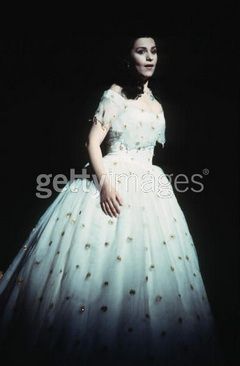
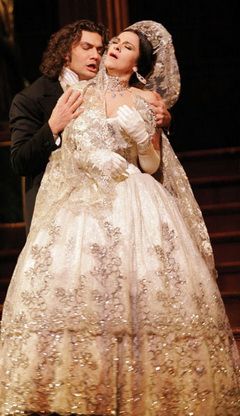
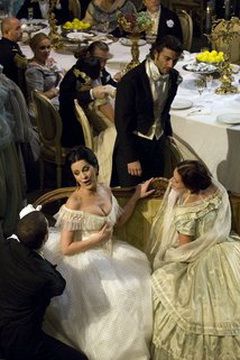
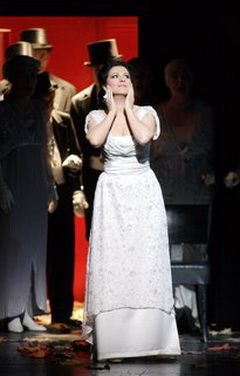




Renee Flemming's dress at the Met in 2003

Elisabeth Futral's dress in Los Angeles in 2006 (the production is set in 1920's and the designer of the dress is Marta Domingo).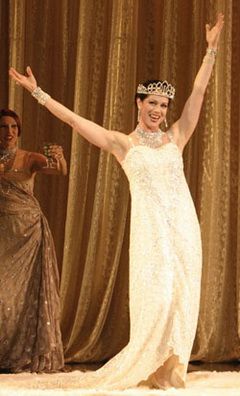

.
But there are some variations. Maybe the most striking one is the act 1 dress worn by Anna Netrebko in the Traviata production from Salzburg in 2005: fitted, red silk damask cocktail dress with a full, knee-length skirt, designed by Dorothea Nicolai. In this particular production the red dress is the only colored attire, the rest of them being black and white.

.
The first scene of Act II offers an interesting challenge for the costume designer. Violetta's dress is meant to convey her eagerness to lead a simple, blissful country life with Alfredo, and the viewer expects a dramatic change in attire, from provocative ball gown to simple country frock. Interpretations of this look, however, are the most varied of all Violetta's costumes.
.
For example Anna Mofo's dress for the 1966 Met production: pale chiffon, multiple ruffles and flounces, long sleeves and high, delicately pin-tucked neckline made it the perfect gown to persuade Monsieur Germont that Violetta is virtuous. 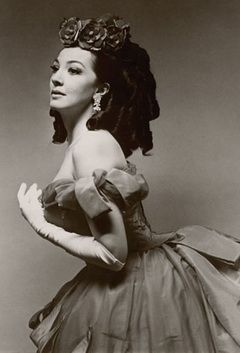 Or Angela's dress for the 2006 Met revival, which she especially requested. An obvious contrast in style is seen in two very different Act II dresses worn by Angela Gheorghiu — the first in the Met's 2006 revival of Franco Zeffirelli's production, the second just one year later at the Teatro alla Scala. The Met staging, which featured Gheorghiu in new costumes that were not part of the original production, presented Violeta in a dress with a delicately feminine appeal, not unlike the one from the Beaton production. It falls into the general silhouette of the late 1840s and, despite its striking pink fabric with an oversize floral motif, proves to be a relatively conventional choice. At La Scala, however, the same scene presents Gheorghiu in a simple chemise and a semi-fitted, boldly patterned robe. Visually stunning, it provides a sense of the ease of country life, but it is unlikely that even a former courtesan would greet guests in such immodest attire during the mid-nineteenth century.
Or Angela's dress for the 2006 Met revival, which she especially requested. An obvious contrast in style is seen in two very different Act II dresses worn by Angela Gheorghiu — the first in the Met's 2006 revival of Franco Zeffirelli's production, the second just one year later at the Teatro alla Scala. The Met staging, which featured Gheorghiu in new costumes that were not part of the original production, presented Violeta in a dress with a delicately feminine appeal, not unlike the one from the Beaton production. It falls into the general silhouette of the late 1840s and, despite its striking pink fabric with an oversize floral motif, proves to be a relatively conventional choice. At La Scala, however, the same scene presents Gheorghiu in a simple chemise and a semi-fitted, boldly patterned robe. Visually stunning, it provides a sense of the ease of country life, but it is unlikely that even a former courtesan would greet guests in such immodest attire during the mid-nineteenth century. 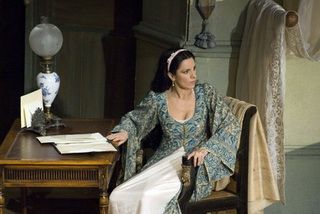
 Or Angela's dress for the 2006 Met revival, which she especially requested. An obvious contrast in style is seen in two very different Act II dresses worn by Angela Gheorghiu — the first in the Met's 2006 revival of Franco Zeffirelli's production, the second just one year later at the Teatro alla Scala. The Met staging, which featured Gheorghiu in new costumes that were not part of the original production, presented Violeta in a dress with a delicately feminine appeal, not unlike the one from the Beaton production. It falls into the general silhouette of the late 1840s and, despite its striking pink fabric with an oversize floral motif, proves to be a relatively conventional choice. At La Scala, however, the same scene presents Gheorghiu in a simple chemise and a semi-fitted, boldly patterned robe. Visually stunning, it provides a sense of the ease of country life, but it is unlikely that even a former courtesan would greet guests in such immodest attire during the mid-nineteenth century.
Or Angela's dress for the 2006 Met revival, which she especially requested. An obvious contrast in style is seen in two very different Act II dresses worn by Angela Gheorghiu — the first in the Met's 2006 revival of Franco Zeffirelli's production, the second just one year later at the Teatro alla Scala. The Met staging, which featured Gheorghiu in new costumes that were not part of the original production, presented Violeta in a dress with a delicately feminine appeal, not unlike the one from the Beaton production. It falls into the general silhouette of the late 1840s and, despite its striking pink fabric with an oversize floral motif, proves to be a relatively conventional choice. At La Scala, however, the same scene presents Gheorghiu in a simple chemise and a semi-fitted, boldly patterned robe. Visually stunning, it provides a sense of the ease of country life, but it is unlikely that even a former courtesan would greet guests in such immodest attire during the mid-nineteenth century. 
.
Another suggestive dress appears in the 2007 Rome production.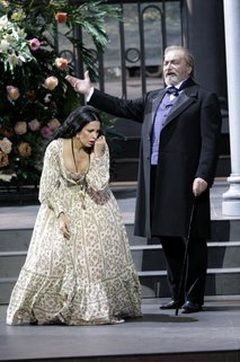

.
For the Opera Night Gala at the Met in 2008 Renee Fleming is wearing a colorful dress for the first scene of the second act, signed by the famous designer Christian Lacroix. This dress doesn't show at all simplicity and it would have fitted better the second part of this act. Lacroix himself describes the dress as a "vast tea gown" of sweeping, multicolor pastel chiffon with feather "flowers" sprinkled along the bodice.

.
In to the second scene of Act II, Violeta is presented again as a courtesan, but her sense of desperation is obvious. The dress for Flora's party changes color. From pure white to deep black or red. In one of the productions Callas's dress is black. 

Jarmila Novotná also wears a black dress for the 1940 Traviata at the Met, Angela Gheorghiu wears a red dress for the 2007 performance at La Scala and a black and red dress for the 2009 performace in Munich. 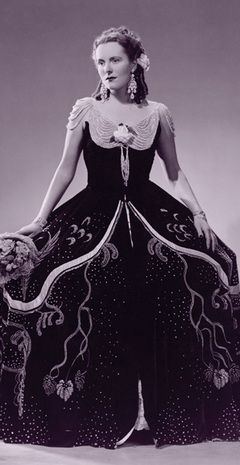
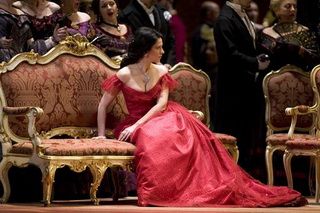
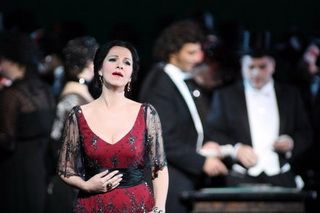 And Christian Lacroix created a beautiful black and red silk dress for Renee Fleming
And Christian Lacroix created a beautiful black and red silk dress for Renee Fleming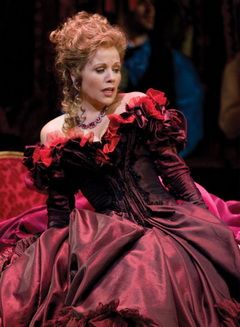
.
The dress for the third act has less variations but it tells Violeta's story. She lost all her possessions and all her glamour is now gone. This dress is supposed to show a small and fragile woman. One production, featuring Gheorghiu at the Royal Opera, Covent Garden, in 1994, shows Violeta in the typical long white-cotton shift. However, designer Bob Crawley also includes in this scene a relic of her previously fashionable life: a cage crinoline, on a dress form, lingers in a shadowy corner of the bedroom.


 And Christian Lacroix created a beautiful black and red silk dress for Renee Fleming
And Christian Lacroix created a beautiful black and red silk dress for Renee Fleming
.
The dress for the third act has less variations but it tells Violeta's story. She lost all her possessions and all her glamour is now gone. This dress is supposed to show a small and fragile woman. One production, featuring Gheorghiu at the Royal Opera, Covent Garden, in 1994, shows Violeta in the typical long white-cotton shift. However, designer Bob Crawley also includes in this scene a relic of her previously fashionable life: a cage crinoline, on a dress form, lingers in a shadowy corner of the bedroom.
The same kind of dress appears in the 2007 La Scala Traviata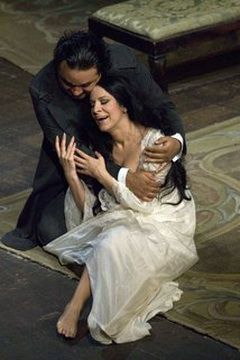

.
What do you think? Would ROH and MET keep their traditional dresses for Violeta during the next season? As we saw, the costumes change also according to the fashion. More and more famous designers started their cooperation with opera houses around the world. How would the next dress for Violeta look like?
.
0 comments:
Post a Comment